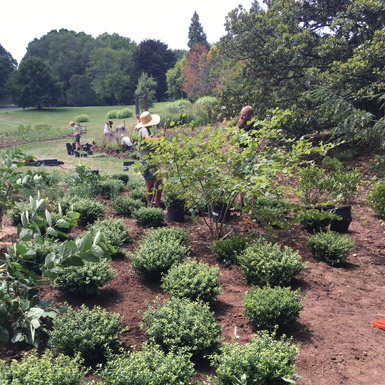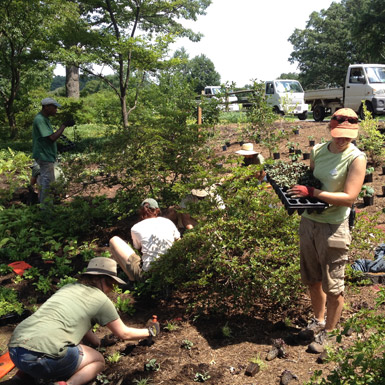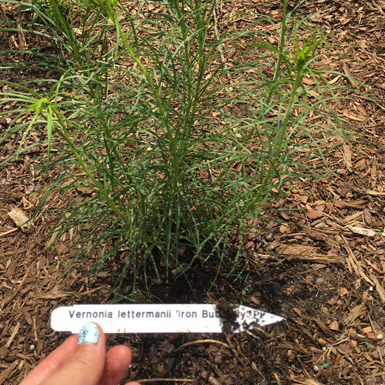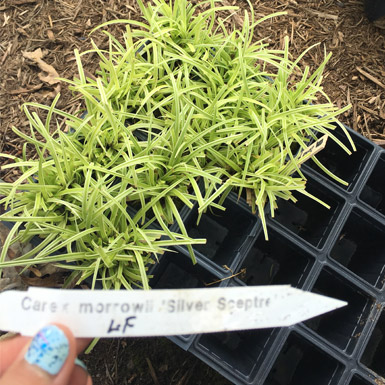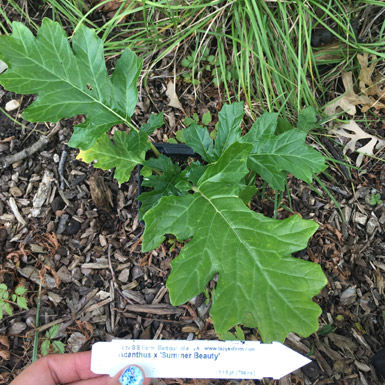Lessons Learned on Planting Day
OvS Design Team member You Li recently spent two days planting the Friendship Garden at the National Arboretum in Washington, DC.
As an entry-level landscape designer, it was a great learning experience to plant at the U.S. National Arboretum’s Friendship Garden. My name is You Li and myself, OvS Designer Lili Herrera, and Intern Ben Scott planted the Friendship Garden on two very hot summer days. I learned a few lessons about planting through some of the hottest days of the summer, which I would like to share with you.
Lesson #1: See the site. Feel the site. Analyze the site. Understand your plants and put them where they belong.
What is it like planting on site as a landscape architect? How different is it from drawing it on paper or computer? Well, our responsibility is to assess the site conditions and the available plants, then lay out the plants as desired. As you might imagine, you don’t always get the exact plants in the exact quantities that you ordered. Nurseries might send you substitutions because the requested plants are unavailable. Don’t be surprised if you need to make adjustments in the field.
Additionally, the site conditions might be quite different than what you had planned for. A few white oak trees at Friendship Garden had been cut down due to unidentified issues (scientists at National Arboretum are still trying to solve the mystery). As a result, the garden receives much more sun than we anticipated, so we had to rearrange the plants to accommodate the sunnier conditions on-the-fly.
As part of the design team, you are responsible for instructing the contractors and other workers to put the plants in ground correctly, which is much easier said than done. Everything fluctuates and changes in the field on planting day. You wish you had multiple hands and could be in multiple places at once to sort things out in the chaos and heat – all while the clock ticks.
Lesson #2: Paint with plants. Be creative and artistic when planting.
Lili decided what plants would go where and used soluble spray paint to define the bed-lines on site. Ben and I helped to move the plants to the right place and helped to lay them out with the proper spacing.
It is very different from drawing bed-lines on the computer (CAD) because every single line in CAD is now three-dimensional and real. You really have to process all the information around you and make each consideration mindfully and efficiently.
OvS Principal Lisa Delplace suggested that we make the bed-lines ‘fuzzy’ so the plants could comingle. I have to admit at first I did not quite understand how to make the bed-lines ‘fuzzy,’ especially when you can’t see the lines in reality. Lili taught me a method which I find super helpful. Think of it as if you are drawing the bed-lines with a watercolor pencil and then use a wet brush to blend the colors. You won’t see individual colors, but more of an artistic blend. Planting is just a different way of drawing, painting, or even sculpting.
Molinia caerulea ‘Windspiel’ and Rudbeckia maxima are frequently used accent plants at OvS. They can grow to about 7-feet tall and they stand out like tall, slender, and beautiful sculptures in a museum. We like to group 3 to 5 of them together and mix them with some low-growing perennials and grasses. This allows the plants to relate to one another and gives more presence to the garden.
Lesson #3: Take time to get to know plants OFFLINE.
Seeing, touching, and feeling the plant is akin to meeting a friend’s friend. You might have heard interesting stories about this friend or seen their picture, but physical interaction makes an immense difference. For example, I now find Geranium macrorrhizum very attractive. Its soft foliage looks like snowflakes and has an appealing minty scent. I would not remember this particular plant so intimately without touching, feeling, smelling, and planting it.
The National Arboretum was kind enough to give me a list of some interesting plants they recommended for this garden. Please meet some new friends.
Camellia japonica ‘Anacostia’
Ilex crenata ‘Soft Touch’
Anemone ‘Wild Swan’
Echinacea ‘Green Jewel’
Epimedium versicolor ‘Thunderbolt’
Vernonia noveboracensis ‘Iron Butterfly’
Scutellaria incana
Agastache ‘Purple Haze’
Helianthus angustifolius ‘Gold Lace’
Acanthus hungaricus ‘Summer Beauty’
Carex ‘Silver Scepter’
I want to thank the National Capital Area Garden Club (NCAGC), their wonderful Friendship Garden Chairman, Ellen Spencer and the amazing crew at National Arboretum. Please stop by to check out the National Arboretum – it is a beautiful public garden in the middle of the city.

